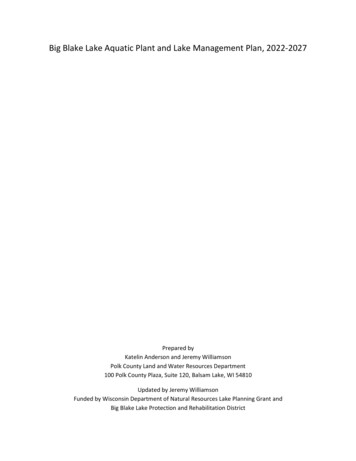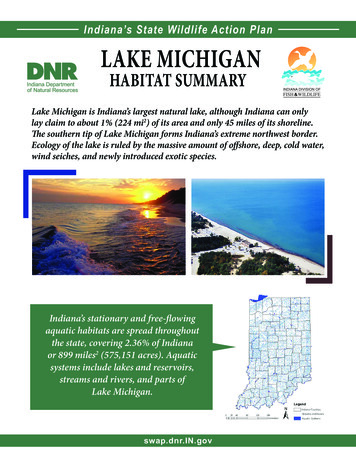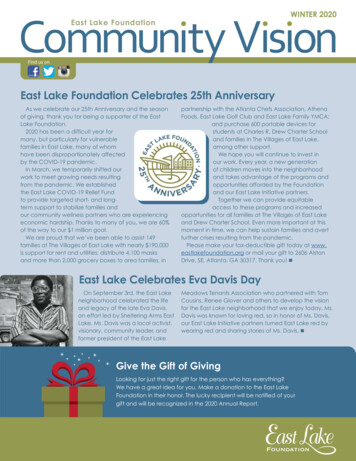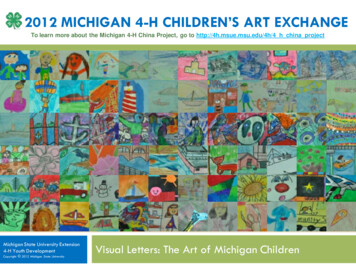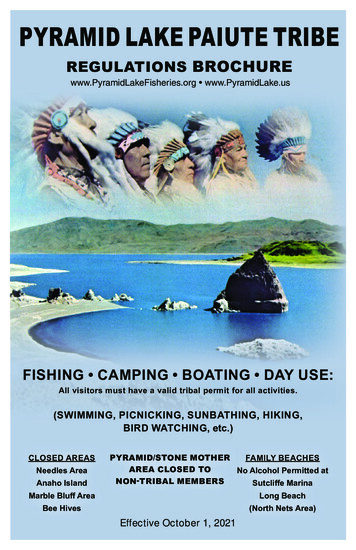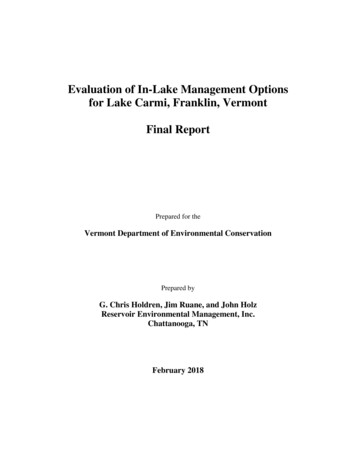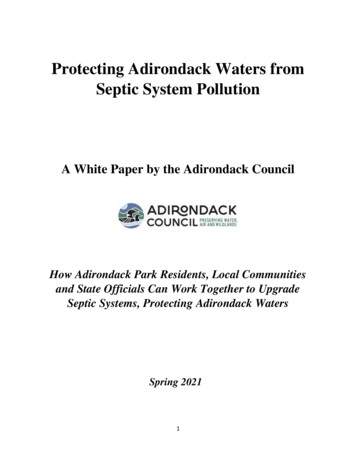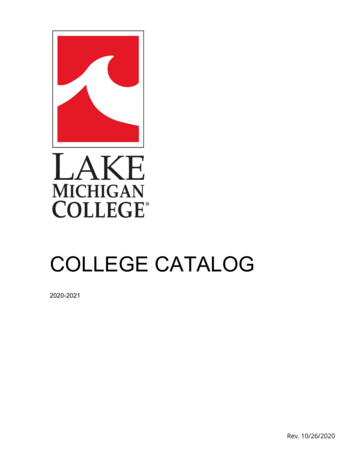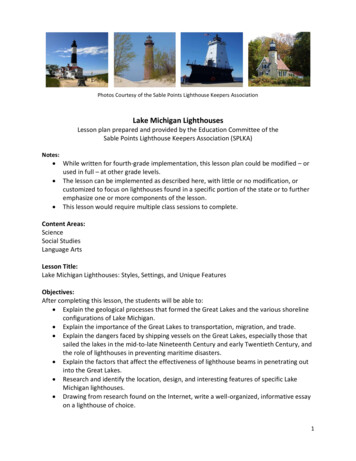
Transcription
Photos Courtesy of the Sable Points Lighthouse Keepers AssociationLake Michigan LighthousesLesson plan prepared and provided by the Education Committee of theSable Points Lighthouse Keepers Association (SPLKA)Notes: While written for fourth-grade implementation, this lesson plan could be modified – orused in full – at other grade levels.The lesson can be implemented as described here, with little or no modification, orcustomized to focus on lighthouses found in a specific portion of the state or to furtheremphasize one or more components of the lesson.This lesson would require multiple class sessions to complete.Content Areas:ScienceSocial StudiesLanguage ArtsLesson Title:Lake Michigan Lighthouses: Styles, Settings, and Unique FeaturesObjectives:After completing this lesson, the students will be able to: Explain the geological processes that formed the Great Lakes and the various shorelineconfigurations of Lake Michigan. Explain the importance of the Great Lakes to transportation, migration, and trade. Explain the dangers faced by shipping vessels on the Great Lakes, especially those thatsailed the lakes in the mid-to-late Nineteenth Century and early Twentieth Century, andthe role of lighthouses in preventing maritime disasters. Explain the factors that affect the effectiveness of lighthouse beams in penetrating outinto the Great Lakes. Research and identify the location, design, and interesting features of specific LakeMichigan lighthouses. Drawing from research found on the Internet, write a well-organized, informative essayon a lighthouse of choice.1
MI Content Standards:Science: 4-ESS2-1, 4-ESS2-2, 4-ESS3-2 (Earth’s Systems: Processes that Shape the Earth); 3-5-ETS1-1, 3-5ETS1-2 (Engineering Design)Social Studies: 4 – H3.0.1, 4 – H3.0.4 (History); 4 – G1.0.1, 4 – G1.0.3, 4 – G2.0.2, 4 – G4.0.1, 4 – G4.0.3(Geography)Reading Standards for Informational Text for Grade 4 Students (see 1, 3, 7, 9 and 10)Writing Standards for Grade 4 Students (see 1, 2, 4, 5, 6, 7 and 10)Standard 10: Range, Quality, Complexity of Student Reading K-5Range of Text Types for K-5: Literary Nonfiction and Historical, Scientific, and Technical TextsMaterials:Classroom computer with projection capability, student access to the Internet and writing technologyActivities: Provide an overview of the geological events that created the Great Lakes, emphasizingvariations in lakeshores Discuss the importance of the Great Lakes for transportation, immigration, shipping and trade Discuss the various vessels that sailed the Great Lakes during the time when most lighthouseswere built and the dangers the lakes presented to these vessels Explain the factors that affect penetration of lighthouse beams out into the lakes Discuss the various styles of lighthouses found on the Great Lakes and the relationship betweenlighthouse style and shoreline setting Assign Lake Michigan Lighthouses Internet Scavenger Hunts #1 and #2 to individuals or smallgroups, score and discuss (see enclosed summary table for teacher reference) Assign research and written essay on a Lake Michigan lighthouse (location, need, style andconnection to setting, brief history, interesting features)Assessment: Participation in individual/small-group research Participation in discussion Research and essay writingWriting Assignment: Conduct Internet research on a Lake Michigan lighthouse of choice. Based uponinformation from at least two websites, write a well-organized, informative essay that addresses thefollowing: The location, setting, and corresponding style of the lighthouse The history of the lighthouse Features of the lighthouse and its history that you find especially interestingOptional additional element for the assignment: Print off a map of Lake Michigan lighthouses (forexample, see: assistance-program/2020-lighthouse-map-web.pdf) and ask each memberof the class to “claim” a different lighthouse for the required essay and, if you choose, a briefpresentation to the class. After writing their essays, each member of the class presents a brief (e.g., fiveminutes) overview of her/his chosen lighthouse to the class, drawing from at least two visual aids (e.g.,photos, video clips, maps, drawings) projected on the classroom screen.Lesson ContentThe Great Lakes have been home to 379 lighthouses, 102 of which are found on Lake Michigan. Thestate of Michigan borders on the three largest Great Lakes. Michigan is home to over 140 lighthouses,2
more than any other state; 42 of these historic structures are located on the Lake Michigan shoreline.Michigan’s lighthouses vary in structure and design, depending largely on their location and the natureof the shoreline on which they reside.Formation of the Great LakesA billion years ago, volcanic activity formed a fracture that developed in two forks from the current LakeSuperior to the location of the current states of Alabama and Oklahoma. Over the next 20 million years,lava intermittently flowed from the fracture, creating mountains that covered areas now known asnorthern Wisconsin and Minnesota and eastern Canada that eroded over time. As volcanic activitycontinued over time, molten magma formed an enormous rock basin that eventually would hold LakeSuperior.The volcanic activity that formed the region was replaced by glaciers, thousands of feet thick in someplaces, about 14,000 years ago. The ice sheets that flowed over the land leveled mountains and createdenormous valleys. In the north, where hard bedrock predominated, only the overlaying layers wereremoved; the softer shales and sandstone in the south were more significantly affected. The glaciersmelted and began receding about 10,000 years ago; they left behind high ridges, between which hugelakes were left behind.In the northern Great Lakes, the rock was resistant enough to leave rocky shorelines ringed by cliffs. TheBruce Peninsula, across Lake Huron from Alpena, MI, features rugged rocky cliffs and cobble beaches;however, sand beaches and dunes line the indented and protected shoreline on the opposite side ofLake Huron. On the other side of Michigan, the eastern shore of Lake Michigan has some of the finestsandy beaches in the world. The Great Lakes also contain an estimated 35,000 islands.Importance of the Great LakesThe Great Lakes contain 20% of the world’s surface fresh water. All the lakes’ basins are linked, forminga continuous drainage basin, and a series of lakes, rivers, and waterways connect them to the AtlanticOcean. As a result, the Great Lakes have been a center for migration, transportation, fishing, and tradefor thousands of years.The Iroquois Nation were among the first settlers of the Great Lakes, followed by European explorers.The earliest trade was for fur; eventually, a bustling shipping industry, which reached its height by thelate 1800’s and early 1900’s, moved grain, livestock, iron, coal, lumber, cement, stone, fish, salt, andeven Christmas trees throughout the lakes.Vessels, Dangers, and LighthousesFor a very long time, the enormous size of the Great Lakes has presented the captains of trading vesselswith both opportunities and dangers. With nearly 9,500 miles of coastline, the lakes have enabledshipping to play a significant role in the economics of the Great Lakes region. For example, some of thenation’s largest grain-shipping ports are located on the Great Lakes. Also, the iron ranges near LakeSuperior have been the primary source of ore for North America’s iron and steel production for morethan a century.Some Lake Michigan ports are located in protected bays, while others are situated near rocky shoals, atthe mouths of rivers, or in narrow channels. To reach these ports, vessels often must sail alongshorelines whose depth can change dramatically, and vessels often seek shelter in the ports during theviolent storms that can suddenly develop on the Lakes. Storms that cross the Great Lakes arise whentwo air masses collide. As the wind blows across the surface of the lakes, energy is transferred from thewind to the surface of the water, causing currents and waves. Storms can arise unexpectedly, and the3
resulting waves can be enormous. Ice can also create dangerous conditions, especially if a ship captainmiscalculates the depth or firmness of the ice.Dangers like these have caused over 6,000 shipwrecks in the Great Lakes, with a loss of over 30,000lives. As a result, some 379 lighthouses have been built at strategic locations to guide Great Lakesmariners, and over 200 of these beacons are still active. Most of the lighthouses were built in the midto-late 1800’s, when wooden schooners and early steamships were especially susceptible to thedangerous conditions on the lakes (for example, documents/hgl/default.asp?ID c023).For a lighthouse to be effective in alerting sailors to dangers, its beam must be visible for a considerabledistance out onto the lake; this distance is limited by the curvature of the earth and by the elevation ofthe lighthouse. So, to be effective, a lighthouse on a high cliff or bluff would not need to be as tall as alighthouse on the shoreline. Also, a lighthouse is visible farther out on the lake from the deck of a shipthan from the surface of the water. For example, a 60-foot-tall structure is visible from a distance of 11miles, or 16 miles on the deck of a ship; a 90-foot-tall structure is visible from a distance of 12 ½ miles,or 17 ½ miles on the deck of a ship; and a 110-foot-tall structure is visible from a distance of 14 miles, or19 miles on the deck of a ship.Great Lakes lighthouses are located along sandy shorelines (e.g., Little Sable Point .asp?ID 193), on rocky cliffs (e.g., Split Rock ns/state-parks/split-rock-lighthouse/), at the ends of long piers(e.g., Grand Haven Lighthouse: https://www.lighthousefriends.com/light.asp?ID 189), on rock reefs orrocky shoals (e.g., Port Austin Light: , at river mouths(e.g., Cheboygan River Front Range Lighthouse: https://www.lighthousefriends.com/light.asp?ID 216),on islands (e.g., Grand Island North ewp Grand Island North Channel Light Lighthouse Munising MI United States, and on points of land (e.g., Whitefish Point Light ).A person standing anywhere in Michigan is within 85 miles of one of the Great Lakes. Michigan has over3,200 miles of shoreline, more than any other state except Alaska, and the most freshwater shoreline inthe world; over 140 lighthouses, more than any other state, have been built along its shores.Michigan lighthouse dwellings and towers were designed in a variety of styles. While some lighthouseswere designed with their own individual styles, others fell within one of several style categories:Schoolhouse: Sand Point Lighthouse - seNorman Gothic: White River Light Station - https://www.splka.org/whiteriver.htmlConical: Tawas Point Lighthouse - https://www.lighthousefriends.com/light.asp?ID 175Skeletal: Whitefish Point Light Station - : Manistique East Breakwater Lighthouse - kwater-lighthouseSquare: Forty Mile Point Lighthouse - https://40milepointlighthouse.org/Round: Point Betsie Lighthouse - ouseEven “sparkplug” style: Harbor Beach Lighthouse - useFor context, project the map of Michigan -web.pdf4
Scroll through the list of Lake Michigan lighthouses. Ask students if they have visited any of them; do anInternet search of lighthouses noted and project photos. Ask students if they are interested in any ofthe other Lake Michigan lighthouses; search and project photos of these.Additional resource: Although portions are quite technical in nature, you might consider showing anddiscussing all or parts of the National Geographic Channel’s documentary Drain the Great Lakes:https://www.youtube.com/watch?v VAo4qvP6o2EReferencesEnvironmental Education for Kids: rmedU.S. Army Corps of Engineers: consin Sea Grant: ion-of-the-great-lakes/howthey-were-made/Awesome Mitten: were-formed/EOS – Science News by Advancing Earth and Space Science: reat-lakesMaritime History of the Great a/documents/hgl/default.asp?ID c023Bruce Peninsula Biosphere Association: fMinnesota Historical er/shipwrecks/mpdf/craft.phpA Century of Light – Captain Edward %20the%20gl.htmlGreat Lakes Shipwreck Museum: /shipwrecks/Michigan Economic Development -web.pdfSeeing the Light (Terry Pepper): .htmSelected Lake Michigan LighthousesName, DateMcGulpin Point1869Location3 mi. west ofMackinaw CitySettingWooded shorelineStyleNorman Gothicstyle dwelling,octagonal bricktowerWhite Shoal191020 mi. west ofMackinac BridgeOn offshore reefConical steel andconcrete towerNotesWas determinedto be ineffective,replaced by lightson MackinacBridgeMarks dangerousshallow shoal;only “candy cane”striped lighthouseon the GreatLakes, 121 ft. tall;original SecondOrder Fresnel lenson display atWhitefish Point5
Beaver Island1858South end ofBeaver Island,largest island inLake MichiganSt. Helena Island,6 mi. west ofMackinac BridgeLocated on a bluffon the southernend of the islandDwelling, conicalbrick towerFlat, grassy islandshorelineDwelling, conicalbrick towerCat’s Head Pointat Leelanau StatePark, entrance toGrand TraverseBayEast shore ofManitou Island, tothe south of theharborGrassy woodedshorelineSchoolhouse-stylebrick dwelling,integral squareroof-mountedlanternDwelling, brickconical tower5 mi. north ofFrankfort, markskey turning pointfor ships enteringor exitingManitou Passage1.5 mi. north ofLudington StatePark campgroundSandy shorelineDwelling, roundbrick towerBeach, sanddunesDwelling, steelplated conicaltowerLudington NorthBreakwater1924Ludington harborPierhead, at theend of 1,700-footbreakwater;arrowheadbreakwatersprotect theharborPyramidal steeland concretetowerLittle Sable Point1874In Silver LakeState ParkBeach, sanddunesConical bricktowerSt. Helena Island1873Grand Traverse1853South ManitouIsland1871Point Betsie1858Big Sable Point1867Rocky on centerfor CharlevoixPublic SchoolsMuch restorationdone annually byBoy Scout Troop 4from Ann ArborMuseum containsoriginal fourthorder Fresnel lensMarks the narrowManitou Passage,one of the mostdangerous in theGreat LakesMuseum, severalCoast Guardbuildings,elaboratebreakwaters tocontain erosionNavigational aidto guide shipssailing alongcoast; platescover originaldeterioratingbricksMarks entrance toLudington harbor;unique shape ofbase deflectsstrong waves;Fresnel lens madein Pittsburgh, PA;tilts at 4-degreeangleOne of oldestbrick lighthouseson the GreatLakes; markssouthernmost ofthree “bumps” ofland on easternshore of LakeMichigan; Third6
White River LightStation1875Mouth of WhiteLake, just west ofWhitehallOn peninsulaseparating LakeMichigan fromWhite LakeGrand Haven1895In Grand HavenState ParkOn pier atentrance to theGrand RiverHolland1936In Holland StateParkAt the end of thesouth inner pierSt. Joseph1907Mouth of the St.Joseph RiverOn north pierMenomineeNorth Pier1877Marks entrance tothe MenomineeRiver, acrosswhich liesWisconsinAt Escanaba inLudington ParkSand Point1868On end of northpierOn harborwaterfrontLimestoneNorman Gothicstyle dwelling andoctagonal bricktowerTwo redstructures severalhundred feetapart, connectedby catwalk– ironconical tower(inner) and streelplatedsquare/integralwooden erOrder Fresnel lensstill in placeGuided ships intoWhite River;museum; severaloriginal buildingson siteMarks one ofMichigan’s bestdeep-waterharbors; one ofMichigan’s moststriking pierlighthousesMarks channelinto Black Lake;nicknamed “BigRed”; one of mostphotographedlighthouses inMichiganTwo white castMarks entrance toiron lights several St. Joseph Riverhundred feetchannel; originalapart, connectedlight (1832) wasby a catwalk;one of earliestconical towerlighthouses on(outer) andLake Michigan;octagonal/integral considered one ofbuilding (inner)most beautifulstructures on theGreat LakesBright redPrevious fogoctagonal castsignal buildingiron towerand catwalk havebeen removedSchoolhouse-styledwelling/integralbrick towerSomehow builtbackwards, withthe tower facingthe town insteadof the water;original buildingstill stands despitedisastrous fire in1886; fully7
Manistique EastBreakwater1915Seul Choix Point1895Marks the port ofManistique at theentrance to theManistique RiverAbout 16 mi. eastof ManistiqueOn end ofbreakwaterBright red castiron pyramidaltowerWooded shorelineDwelling, conicalwhite brick towerrestored in1990’s; museumNot far fromshore and a parkat the shore endof the breakwaterOnly active site ofa once-thrivingfishingcommunity; alloriginaloutbuildings stillstanding; marks adangerouslimestone shoalextending 100yds. from shore;museumLake Michigan Lighthouses Internet Scavenger Hunt #1Directions: Using information found in Internet searches, match each Lake Michigan lighthouse with itscorresponding description.1. The only “candy cane” striped lighthouse on the Great LakesA. Big Sable Point2. Now serves as an environmental education center for theCharlevoix Public SchoolsB. Grand HavenC. Holland3. Withstood disastrous fine in 1886D. McGulpin Point4. Steel plates protect original deteriorating bricks.E. Beaver Island5. Replaced by lights on the Mackinac BridgeF. St. Joseph6. Two red structures on a catwalk several hundred feet apartG. White Shoal7. “Big Red”H. Ludington North Breakwater8. Original light (1832) was one of the earliest lighthouseson Lake MichiganI. Sand Point9. Unique shape is designed to deflect strong wavesAnswer Key:1. G2. E3. I4. A5. D6. B8
7. C8. F9. HLake Michigan Lighthouses Internet Scavenger Hunt #2Directions: Using information found in Internet searches, match each Lake Michigan lighthouse with itscorresponding description.1. Bright red cast iron pyramidal towerA. Grand Traverse2. Marks a hazardous limestone shoalB. Menominee3. Much of its restoration done by a Boy Schout troopC. Seul Choix Point4. Marks one of the most dangerous passages in the Great Lakes D. Manistique5. Its museum contains original Fourth-Order Fresnel lensE. St. Helena Island6. Site includes several original Coast Guard buildingsand an elaborate breakwater for erosion controlF. Little Sable PointG. Point Betsie7. Marks the southernmost of three “bumps” of land, towerstill contains its original Third-Order Fresnel lensH. South Manitou Island8. At the end of a long pier, fog signal building and catwalkremovedAnswer Key:1. D2. C3. E4. H5. A6. G7. F8. BNote to teachers: SPLKA welcomes your feedback on this lesson plan. Please send any comments andsuggestions for improvement to Cherie Hockenberger at the following address:SPLKAofficemanager@gmail.com. Thanks!9
Lake Michigan Lighthouses: Styles, Settings, and Unique Features Objectives: After completing this lesson, the students will be able to: Explain the geological processes that formed the Great Lakes and the various shoreline configurations of Lake Michigan. Explain the importance of the Great Lakes to transportation, migration, and trade.
